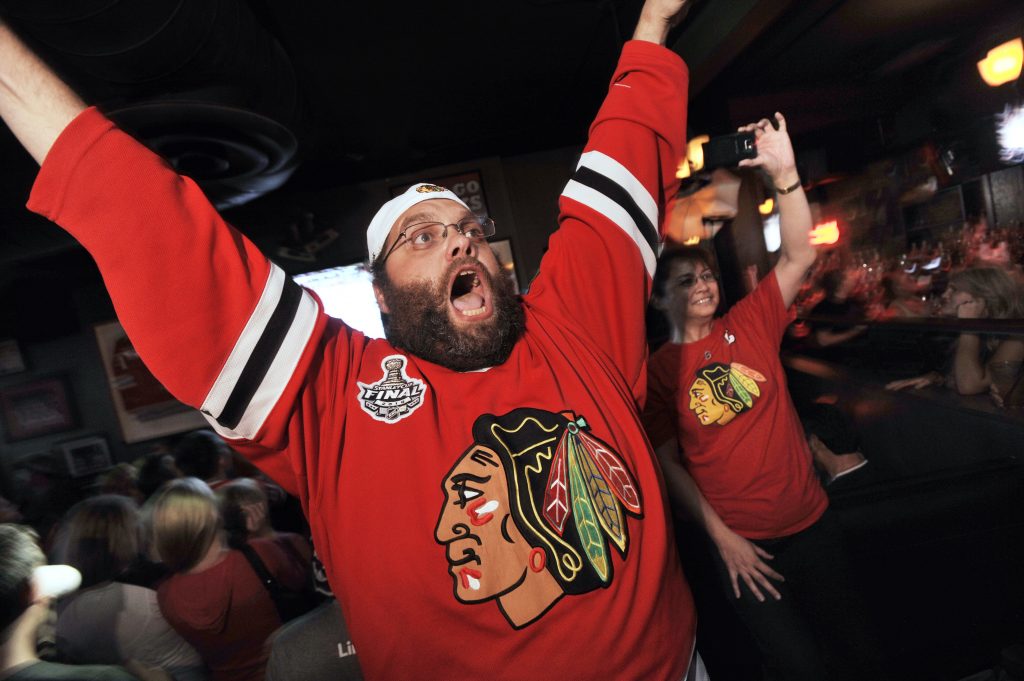Confessions of a Blackhawks Fan

On June 15, 2015, the Chicago Blackhawks hockey team won their third Stanley Cup championship in six years, putting them in contention for the status of a sports dynasty. As a huge fan, I was thrilled to see the people of Chicago rally around the team, with Blackhawks memorabilia plastered all over the city. But as an anthropologist, I had the “existential willies” (to borrow author Robert Fulghum’s memorable phrase) about the team’s name and logo. The victory rekindled a debate I have been having with myself for three decades: How can I continue to support a team that uses a stylized image of a Native American elder as its logo?
As an anthropologist I understand the power of imagery to shape our perceptions of identity. Representations of American Indians shape the public’s concept of Native America, past and present. Anthropologists are supposed to respect difference, not turn to caricature.
So I did a little digging, to see if my fandom could survive a close examination of the Blackhawks name, history, and logo.
The Blackhawks were founded in 1926 by Major Frederic McLaughlin, a Chicago coffee magnate, when he purchased the fledgling Portland Rosebuds of the Pacific Hockey League and moved them to Chicago. The new name came from McLaughlin’s stint in World War I—he had commanded the 333rd Machine Gun Battalion, which was part of the 86th Division (nicknamed “Black Hawks”) in the U.S. Army.
Chief Black Hawk, a leader of the Sauk and Fox—a tribe traditionally located in the Great Lakes region, and later forcibly relocated across the Midwest—fought against the U.S. in the War of 1812, and again in 1832 in the Black Hawk War. Apparently McLaughlin either didn’t see or ignored the irony of honoring his army’s enemy with his hockey team’s name. The team’s official position is that it adopted the nickname of McLaughlin’s Army division—not the name of the Sauk and Fox chief. Yet their iconic logo, designed by McLaughlin’s wife, isn’t a military logo; it’s a stylized profile of a half-smiling Indian. Thankfully their mascot, Tommy Hawk, is a caricature of a giant bird, rather than a Native American.
It’s not unusual for military leaders to apply the names of tribes who resisted American colonialism (e.g., Apache, Comanche, Cheyenne, Kiowa) to weapons systems, vehicles, and fighting units (including Black Hawk helicopters, made famous by the movie Black Hawk Down). These names help to perpetuate “the myth of the worthy adversary”—by honoring the name of the vanquished, the military can suggest that it didn’t take advantage of outgunned and outmanned victims, but instead won difficult battles against worthy opponents. This is a strange sort of honor. The venerable philosopher and social-justice advocate Noam Chomsky challenged us to consider how we would have reacted if the Luftwaffe had named its fighter planes “Jew” or “Gypsy” during World War II. We would have been outraged, and rightfully so.
In sport, there has been much complaint about the appropriation of Native American icons. In 2005, the National Collegiate Athletic Association deemed 18 college nicknames or mascots “hostile or abusive.” Hundreds of colleges, universities, and schools have disowned their Native American mascots—like the University of Illinois’ Chief Illiniwek, finally dispatched in 2007.
But dozens of ethically challenged mascots remain across the U.S., including Chief Wahoo of baseball’s Cleveland Indians. Forty-seven schools in my current home state of Colorado still have racial Native American mascots, ranging from “Chiefs” and “Indians” to “Savages” and even the appalling “Redskins.” Washington D.C.’s professional football team of the same name has been widely and appropriately denounced as racist, including by the courts, which in July 2015 defended the U.S. Patent and Trademark Office’s 2014 decision to rescind the team’s “disparaging” trademark.
The Blackhawks haven’t been such a target. There are some good reasons for that. The Blackhawks don’t use a caricature for their logo or mascot, or a slur for the team name. Some articles have argued that this warrants deference to the team’s official position about honoring a military nickname. The Blackhawks organization adds that it has done a great deal of charitable work with the Native American community in Chicago, primarily through its long-term relationship with the American Indian Center, the nation’s oldest urban Indian center.
Even Indian Country Today, a national news outlet that has been particularly outspoken about the need to retire the Washington D.C. football team’s mascot, reported on the Blackhawks team-name debate without any ire. As far as I can tell, the Sauk and Fox nation has never complained. Overall, it seems that “Blackhawks” passes muster in the court of public opinion. At least it lands smack in the middle of a gray area that I personally find, as a fan, somewhat comforting if still occasionally awkward.
Anthropologists often study the power of totems in other cultures, but we rarely turn this lens on our own cultures.
There’s no lack of company in this gray area. Some tribes have consented to team mascots in their name, most notably Florida’s Seminole and Utah’s Utes, even if the mascot bears no resemblance to anything real in the tribe’s history. If members of those tribes aren’t offended, why should other people be? Notre Dame’s Fighting Irish has similar military roots to the Blackhawks. When potentially offensive names or mascots are adopted by their own people we don’t usually take offense—like the ironic Fighting Whities mascot, used by a University of Northern Colorado intramural basketball team in 2002 (memorabilia sales of which were used to set up a scholarship for Native American students).
Arguably the Blackhawks could just change their logo and name to be safe. An Ojibway artist recently designed a beautiful alternate logo of a black hawk for that purpose, though it was bought in the end by a different sports team with “hawk” in its name.
But changing these things would be a monumental task. Anthropologists often study the power of totems in other cultures, but we rarely turn this lens on our own cultures. In my current hometown of Denver, if the Broncos football team changed their name to the “Donkeys” people would not be pleased. Changing logos and mascots is hard because they become part of individual and collective identities.
All of this provides some solace for the Blackhawks fan in me. But life still would have been easier if I had been born in Toronto and raised as a Maple Leafs fan.
































